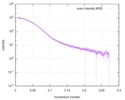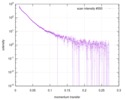[English] 日本語
 Yorodumi
Yorodumi- SASDCL3: Atg1-Atg13 Subcomplex (Serine/threonine-protein kinase ATG1, Atg1... -
+ Open data
Open data
- Basic information
Basic information
| Entry |  |
|---|---|
 Sample Sample | Atg1-Atg13 Subcomplex
|
| Function / homology |  Function and homology information Function and homology information: / Cvt vesicle assembly / : / phagophore / vacuole-isolation membrane contact site / protein targeting to vacuole involved in autophagy / Atg1/ULK1 kinase complex / cytoplasm to vacuole targeting by the Cvt pathway / autophagy of mitochondrion / protein localization to phagophore assembly site ...: / Cvt vesicle assembly / : / phagophore / vacuole-isolation membrane contact site / protein targeting to vacuole involved in autophagy / Atg1/ULK1 kinase complex / cytoplasm to vacuole targeting by the Cvt pathway / autophagy of mitochondrion / protein localization to phagophore assembly site / phagophore assembly site membrane / piecemeal microautophagy of the nucleus / protein kinase regulator activity / phagophore assembly site / reticulophagy /  extrinsic component of membrane / activation of protein kinase activity / extrinsic component of membrane / activation of protein kinase activity /  autophagosome assembly / molecular adaptor activity / autophagosome assembly / molecular adaptor activity /  non-specific serine/threonine protein kinase / non-specific serine/threonine protein kinase /  protein phosphorylation / protein serine kinase activity / protein serine/threonine kinase activity / protein phosphorylation / protein serine kinase activity / protein serine/threonine kinase activity /  ATP binding / ATP binding /  cytosol cytosolSimilarity search - Function |
| Biological species |   Kluyveromyces lactis (strain ATCC 8585 / CBS 2359 / DSM 70799 / NBRC 1267 / NRRL Y-1140 / WM37) (yeast) Kluyveromyces lactis (strain ATCC 8585 / CBS 2359 / DSM 70799 / NBRC 1267 / NRRL Y-1140 / WM37) (yeast) |
 Citation Citation |  Journal: Structure / Year: 2015 Journal: Structure / Year: 2015Title: Solution structure of the Atg1 complex: implications for the architecture of the phagophore assembly site. Authors: Jürgen Köfinger / Michael J Ragusa / Il-Hyung Lee / Gerhard Hummer / James H Hurley /   Abstract: The biogenesis of autophagosomes commences at the phagophore assembly site (PAS), a protein-vesicle ultrastructure that is organized by the Atg1 complex. The Atg1 complex consists of the Atg1 ...The biogenesis of autophagosomes commences at the phagophore assembly site (PAS), a protein-vesicle ultrastructure that is organized by the Atg1 complex. The Atg1 complex consists of the Atg1 protein kinase, the intrinsically disordered region-rich Atg13, and the dimeric double crescent-shaped Atg17-Atg31-Atg29 subcomplex. We show that the PAS contains a relatively uniform ∼28 copies of Atg17, and upon autophagy induction, similar numbers of Atg1 and Atg13 molecules. We then apply ensemble refinement of small-angle X-ray scattering to determine the solution structures of the Atg1-Atg13 and Atg17-Atg31-Atg29 subcomplexes and the Atg1 complex, using a trimmed minipentamer tractable to biophysical studies. We observe tetramers of Atg1 pentamers that assemble via Atg17-Atg31-Atg29. This leads to a model for the higher organization of the Atg1 complex in PAS scaffolding. |
 Contact author Contact author |
|
- Structure visualization
Structure visualization
- Downloads & links
Downloads & links
-Data source
| SASBDB page |  SASDCL3 SASDCL3 |
|---|
-Related structure data
| Related structure data | C: citing same article ( |
|---|---|
| Similar structure data | Similarity search - Function & homology  F&H Search F&H Search |
- External links
External links
| Related items in Molecule of the Month |
|---|
-Models
- Sample
Sample
 Sample Sample | Name: Atg1-Atg13 Subcomplex / Specimen concentration: 1.00-5.20 / Entity id: 633 / 634 |
|---|---|
| Buffer | Name: 20 mM Tris, 200 mM NaCl, 2% glycerol / pH: 8 |
| Entity #633 | Name: Atg1 / Type: protein / Description: Serine/threonine-protein kinase ATG1 / Formula weight: 30.664 / Num. of mol.: 2 Source: Kluyveromyces lactis (strain ATCC 8585 / CBS 2359 / DSM 70799 / NBRC 1267 / NRRL Y-1140 / WM37) References: UniProt: Q6CSX2 Sequence: DSNITPAVES LAAKAFVMYS FAEMKFSQIL PTPPSSTDYD PLSDKRLSNG SCAIEDEEDL DQGRPPSNQT LTSATTKISS ATNVDTQIPA PELKKLCTES LLLYLKALTI LAASMKLTSK WWYENESKNC TLKLNILVQW IRDRFNECLD KAEFLRLKLH AINTSPNSQW ...Sequence: DSNITPAVES LAAKAFVMYS FAEMKFSQIL PTPPSSTDYD PLSDKRLSNG SCAIEDEEDL DQGRPPSNQT LTSATTKISS ATNVDTQIPA PELKKLCTES LLLYLKALTI LAASMKLTSK WWYENESKNC TLKLNILVQW IRDRFNECLD KAEFLRLKLH AINTSPNSQW SDDDPVIFVE KLIYDRALDI SRNAARMEME SGNYNTCELA YATSLWMLEI LLDENFQFNE VYDDEYASNI TSLDESDKEM IKKYISSIAN RLKALKSKMV |
| Entity #634 | Name: Atg13 Autophagy-related protein 13 / Type: protein / Description: Autophagy-related protein 13 Autophagy-related protein 13 / Type: protein / Description: Autophagy-related protein 13 / Formula weight: 8.726 / Num. of mol.: 2 / Formula weight: 8.726 / Num. of mol.: 2 Source: Kluyveromyces lactis (strain ATCC 8585 / CBS 2359 / DSM 70799 / NBRC 1267 / NRRL Y-1140 / WM37) References: UniProt: Q6CWK2 Sequence: FDRTAKPRKS TENPPEDLLE FVKLLEDKKE LNMKPNTILP QQDISNSLMR FQSMKSNNDA LSDNLSMSMS IDQPNV |
-Experimental information
| Beam | Instrument name: Advanced Light Source (ALS) 12.3.1 (SIBYLS) City: Berkeley, CA / 国: USA  / Type of source: X-ray synchrotron / Type of source: X-ray synchrotron Synchrotron Synchrotron | |||||||||||||||||||||||||||||||||
|---|---|---|---|---|---|---|---|---|---|---|---|---|---|---|---|---|---|---|---|---|---|---|---|---|---|---|---|---|---|---|---|---|---|---|
| Detector | Name: Pilatus3 X 2M / Pixsize x: 172 mm | |||||||||||||||||||||||||||||||||
| Scan |
| |||||||||||||||||||||||||||||||||
| Distance distribution function P(R) |
| |||||||||||||||||||||||||||||||||
| Result |
|
 Movie
Movie Controller
Controller





